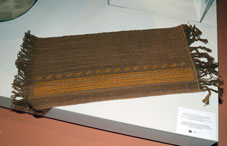
German Archaeological Institute gifts Georgian National Museum fabric created based on joint study
By Khatia Bzhalava
Thursday, July 22
On July 20, 2021, the Director of the Eurasia Department of the German Archaeological Institute Professor Svend Hansen donated to Georgian National Museum a fabric made by German and Georgian specialists based on the results of joint researches.
According to the Georgian National Museum, the fabric was created as a result of an experimental study according to a fragment of fabric found in 2012 in Lagodekhi burial mound dated back to the 3rd millennium B.C. (The expedition was led by Zurab Makharadze).
Georgian National Museum and German Archaeological Institute have been collaborating for many years. In 2018-2019, Frankfurt Archaeological Museum hosted a large-scale exhibition "Gold and Wine - Georgia's Oldest Treasures". The exhibition displayed rich archaeological material, including fragments of fabric found in the N3 burial mound in Ananuri, dating back to the third millennium BC. The conservation of fragments was funded by the Shota Rustaveli National Science Foundation of Georgia. According to the Georgian National Museum, patterns from such an old era are very rare to find. The idea of making similar fabric by using modern techniques and technologies was born while preparing for an exhibition in Germany. An animation was also created for the same exhibition, which demonstrates a detailed reconstruction of the burial mound.
As the Georgian National Museum notes, cooperation with the German Archaeological Institute continues. Both institutions study great inventions of the prehistoric era, including the production of fabric, early agriculture, metallurgy, the wheel, etc. These scientific projects are supported by the German Research Foundation (GRF), Shota Rustaveli National Science Foundation, and other donor organisations.


